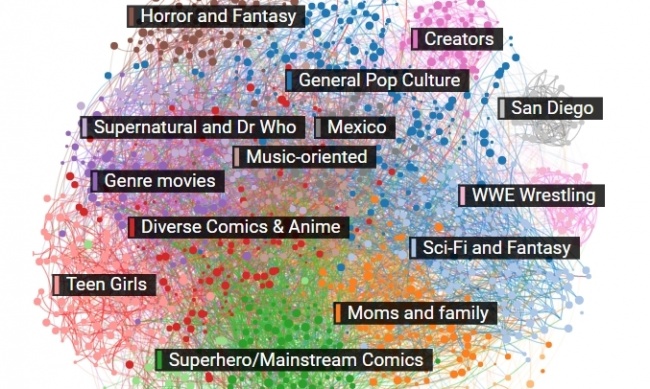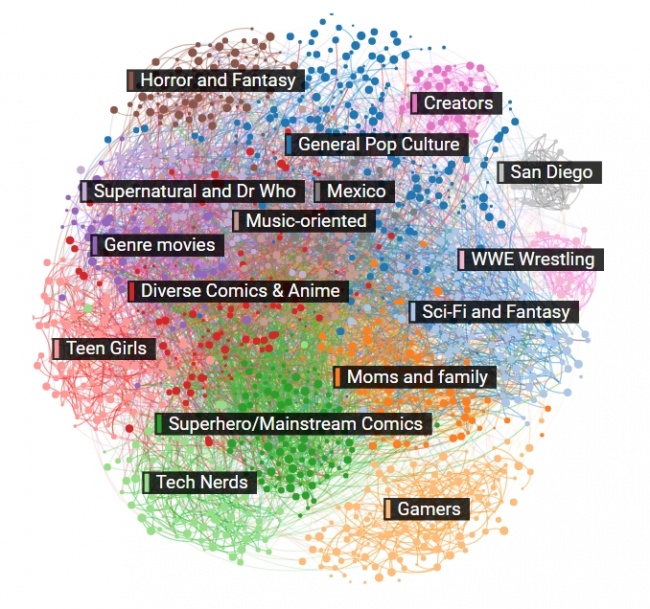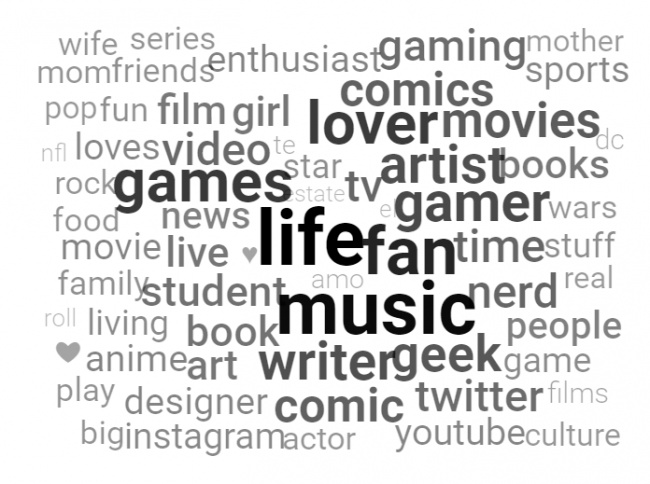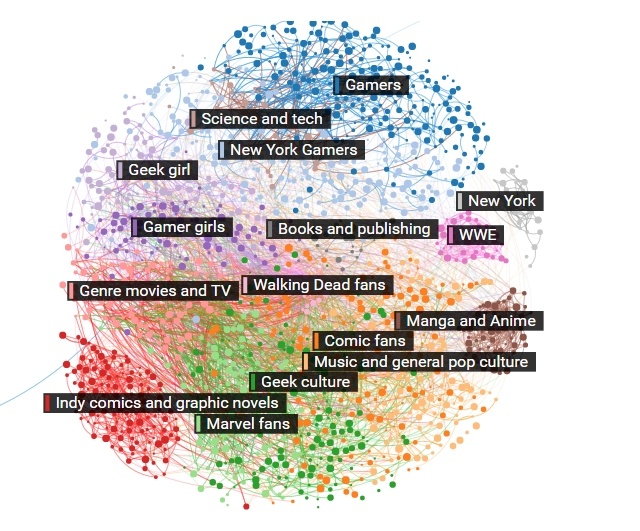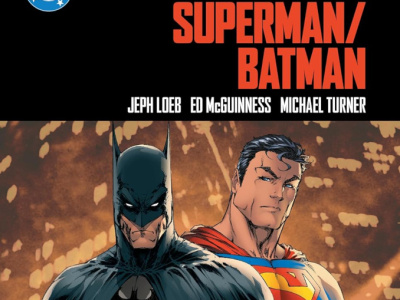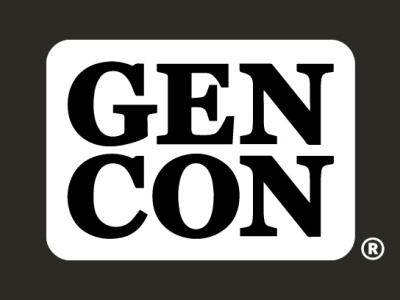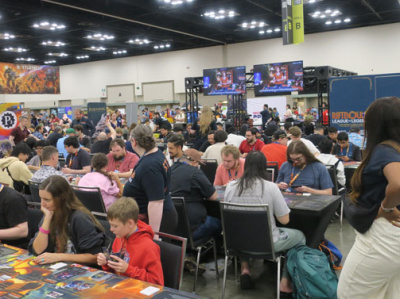Affinio is one of a number of new companies looking at ways to visualize data from social media platforms like Twitter, with the goal of helping marketers get insights into their audience so they can target their messages more effectively. Their product is like a spectroscope for social data: point it at a Twitter handle or keyword, and it breaks the follower base down into clusters and subgroups, highlighting patterns of interest, influence, overlap and divergence. The results are word clouds and colorful charts that help ordinary non-data geeks make sense of a huge volume of information.
As part of some work I was doing with the Microsoft Accelerator in Seattle, where Affinio was honing its product and business strategy, I had a chance to test-drive their technology on a subject near and dear to my heart: the composition of the fan convention audience. Here’s some of what I found.
Identifying the tribes. On June 16, I pulled a report on the followers of the official San Diego Comic-Con Twitter account, @comic_con, which on that day numbered 825,173. For the statistics nerds out there, that’s a pretty robust sample size.
The Affinio tool identified 16 subgroups with distinct characteristics and interests. (See the figure below.) Some are individual fandoms – mainstream comics, diverse comics and anime, genre movies, TV franchises like Doctor Who and Supernatural, videogames and esports, professional wrestling, and general science-fiction and fantasy.
Click image for larger view.There are two large professional communities – creators (artists, writers, actors, entertainment industry pros) and “tech nerds” from software, engineering and science. There’s also clump of people who follow Comic-Con primarily for its association with the city of San Diego, either because they are residents or businesses with a civic interest.
Other groupings are clustered around shared demographics or geography. For example, there were large groups of teen girls, moms and family-oriented fans and Spanish-speaking fans (mainly from Mexico). Affinio can’t analyze the underlying demographics themselves because Twitter doesn’t make profile data like that available, but commonalities become obvious by identifying keywords in their profiles and tweets.
Differences and commonalities. The visualization of the clusters reveals a couple of interesting details. First, a couple of subgroups such as San Diego residents, esport/gaming fans and WWE fans, are really distinct in their interests, as demonstrated by their location at the periphery of the cluster map and the few areas of overlap with the other groups. These folks share an interest in Comic-Con, but little else.
As we move toward the middle of the chart, the array of colors becomes a muddle. The subgroups called out in this central area share a huge number of interests and traits with one another, even though they are distinct in important ways.
Click image for larger view.One thing the Affinio tools lets you do is zoom in to a particular subgroup to figure out who they follow, what brands they like, and what media resonates with them. When wrestling fans go for a snack, they’re likely to scarf down Doritos, Arby’s, and KFC, whereas the junk food of choice for tech nerds is Dominos, Wendy’s and Pizza Hut. Moms like their Dunkin Donuts, or at least they like them proportionately more than other groups. You’ll find horror fans haunting the local Starbucks when they’re not out shopping for gothic underthings at Victoria’s Secret or binge-watching Netflix. These little differences in consumption habits contribute subtly to our identities – and they are good to know if you are a brand trying to better understand your customers.
Comparing Con audiences. One point I’ve been making – mostly on intuition – for the past few years is that San Diego Comic-Con is fundamentally a different kind of event from other pop culture shows, even if it is perceived to be in competition with other 100K+ cons. Now I’ve got some data to back that up.
I ran an analysis of the 152,677 followers of @ny_comic_con, the official account of ReedPop’s New York ComicCon and compared it with what I found from SDCC.
Click image for larger view.One look at the word clouds tells the story. NYCC is a huge show for gamers, with over 30% showing a strong interest in videogaming and esports. 30% are fans of mainstream, independent or manga-style comics; 20% identify with other aspects of geek culture, including a big group whose primary interest is The Walking Dead.
Click image for larger view.Notably, the subgroups at NYCC have much less overlap with one another. They really are tribes into their own thing first and other areas of pop culture second or not at all. The only important demographic split is around gender, with “Geek Girl” and “Gamer Girl” communities standing out as clusters with important differences in tastes and behavior from others with the same interests.
In terms of the geography of the Twitter follower-base, NYCC and eight other large North American shows I analyzed all draw primarily from their home regions, even though they are to a certain extent destinations for some travelling fans. SDCC’s audience is global, with the biggest clusters in the Northeast and West Coast of the US, the UK, Western Europe and Mexico, but a notable presence in Australia, Asia, the Middle East and Latin America.
According to this data at least, it’s clear that NYCC and similar events are giant regional shows that aggregate niche fandoms, whereas SDCC is a mass media event that appeals to a more global audience with broader, overlapping interests in pop culture of all kinds.
Big Data vs. Big Ignorance. There’s a lot more insight to be gleaned from this kind of data, and plenty of tools like this coming down the pipe from startups. Considering the huge ongoing commercial interest in the geek culture audience, often from companies that base marketing and messaging strategies on outdated assumptions and condescending prejudices about who their customers are and what they like, it’s hard to see how players in the industry can do without this kind of insight… even if it’s a little scary to consider what they might do with it.
The opinions expressed in this column are solely those of the writer, and do not necessarily reflect the views of the editorial staff of ICv2.com.
Rob Salkowitz (@robsalk) is the author of Comic-Con and the Business of Pop Culture.



